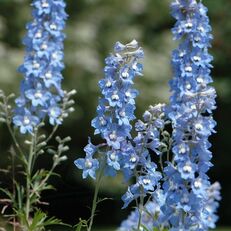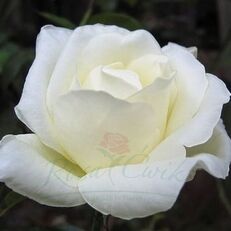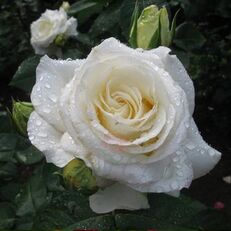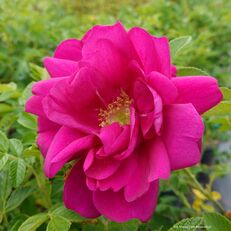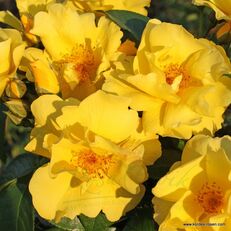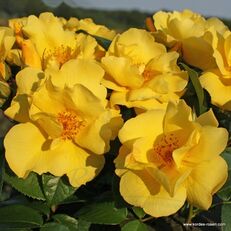Płomyk Wiechowaty Phlox paniculata 'Famous Pink'





≈ $ 5.32
Species Description
The panicle flower forms raised tufts of stiff, unbranched, leafy stems 80-120 cm high, at the tops of which dense, semicircular corymbs appear in summer. The impressive, fragrant inflorescences are suitable for cutting. The intensity of the scent depends on the air temperature. If the morning is warm, the floral aromas reach their maximum concentration at noon. However, when the air temperature begins to rise only in the afternoon, the flowers will smell the strongest in the evening. Several hundred varieties are grown in gardens, which differ in flowering time, height and mosaic of colours (white, pink, orange, red, lilac, purple), single-coloured or with a clearly marked eye. After flowering, it is recommended to cut the faded shoots to encourage the plant to continue flowering in autumn. The panicle flower is a durable, reliably flowering perennial, very popular in garden plantings. However, it is a rather demanding plant. It grows everywhere, but does not always reach the right size and blooms abundantly. It should be planted in fertile, humus, permeable soil that is quite moist in summer. The place of cultivation should be sheltered from winds, the position should be sunny or only slightly shaded on the south side. The perennial grows poorly, is ill and blooms poorly when planted in the shade, under the canopy of trees. It is recommended to divide and replant the plants every 4-5 years. The paniculate flame is planted in flower beds in smaller or larger groups, it looks interesting planted along paths in the form of an espalier. It attracts butterflies and bees.
Features of the Plant
Flowering period: VII-IX
Height with flower: 40
Height without flower: 30
Flower color: pink
Leaf color: green
Location: sunny
Water requirements: dry
Soil pH: neutral - pH 6.6 - 7.2
Soil type: average garden
Frost resistance: group 4 -34.4 to -28.9
Number of plants per m²: 6
fragrant
cut flower
attracts butterflies
honey-bearing
discount
Opis Gatunku
Płomyk wiechowaty tworzy wzniesione kępy sztywnych, nierozgałęzionych, ulistnionych łodyg o wysokości 80-120 cm, na szczytach których latem pojawiają się gęste, półkoliste baldachogrona. Okazałe pachnące kwiatostany nadają się do cięcia. Intensywność zapachu zależy od temperatury powietrza. Jeśli poranek jest ciepły, aromaty kwiatowe uzyskują maksymalne stężenie już w południe. Gdy jednak temperatura powietrza zaczyna wzrastać dopiero po południu, kwiaty najmocniej będą pachnieć wieczorem. W ogrodach uprawianych jest kilkaset odmian, które różnią się terminem kwitnienia, wysokością oraz mozaiką kolorów (białe, różowe, pomarańczowe, czerwone, liliowe, fioletowe) jednobarwne lub z wyraźnie zaznaczonym oczkiem. Po przekwitnięciu zaleca się przycinać przekwitnięte pędy, by pobudzić roślinę do kontynuowania kwitnienia jesienią. Płomyk wiechowaty jest trwałą, niezawodnie kwitnącą byliną, bardzo popularną w nasadzeniach ogrodowych. Należy jednak do roślin dość wymagających. Rośnie wszędzie, ale nie zawsze osiąga właściwe rozmiary i obficie kwitnie. Powinien być sadzony w glebie żyznej, próchnicznej, przepuszczalnej i latem dość wilgotnej. Miejsce uprawy powinno być osłonięte od wiatrów, stanowisko winno być słoneczne lub tylko nieznacznie ocienione od strony południowej. Bylina źle rośnie, choruje i słabo kwitnie gdy posadzona jest w cieniu, pod okapem drzew. Zaleca się dzielenie i przesadzanie roślin co 4-5 lat. Płomyk wiechowaty wysadza się na rabatach w mniejszych lub większych grupach, ciekawie prezentuje się wysadzany wzdłuż ścieżek w formie szpaleru. Przyciąga motyle i pszczoły.
Cechy Rośliny
Termin kwitnienia: VII-IX
Wysokość z kwiatem: 40
Wysokość bez kwiata: 30
Kolor kwiatów: różowe
Kolor liści: zielone
Stanowisko: słoneczne
Wymagania wodne: sucho
Odczyn gleby: obojętny - pH 6,6 - 7,2
Typ gleby: przeciętna ogrodowa
Mrozoodporność: 4 grupa -34,4 do -28,9
Liczba roślin na m²: 6
pachnąca
kwiat cięty
przyciąga motyle
miododajna
rabatowa
If you decide to buy equipment at a low price, make sure that you communicate with the real seller. Find out as much information about the owner of the equipment as possible. One way of cheating is to represent yourself as a real company. In case of suspicion, inform us about this for additional control, through the feedback form.
Before you decide to make a purchase, carefully review several sales offers to understand the average cost of your chosen equipment. If the price of the offer you like is much lower than similar offers, think about it. A significant price difference may indicate hidden defects or an attempt by the seller to commit fraudulent acts.
Do not buy products which price is too different from the average price for similar equipment.
Do not give consent to dubious pledges and prepaid goods. In case of doubt, do not be afraid to clarify details, ask for additional photographs and documents for equipment, check the authenticity of documents, ask questions.
The most common type of fraud. Unfair sellers may request a certain amount of advance payment to “book” your right to purchase equipment. Thus, fraudsters can collect a large amount and disappear, no longer get in touch.
- Transfer of prepayment to the card
- Do not make an advance payment without paperwork confirming the process of transferring money, if during the communication the seller is in doubt.
- Transfer to the “Trustee” account
- Such a request should be alarming, most likely you are communicating with a fraudster.
- Transfer to a company account with a similar name
- Be careful, fraudsters may disguise themselves as well-known companies, making minor changes to the name. Do not transfer funds if the company name is in doubt.
- Substitution of own details in the invoice of a real company
- Before making a transfer, make sure that the specified details are correct, and whether they relate to the specified company.
Seller's contacts


 Poland
Poland 





